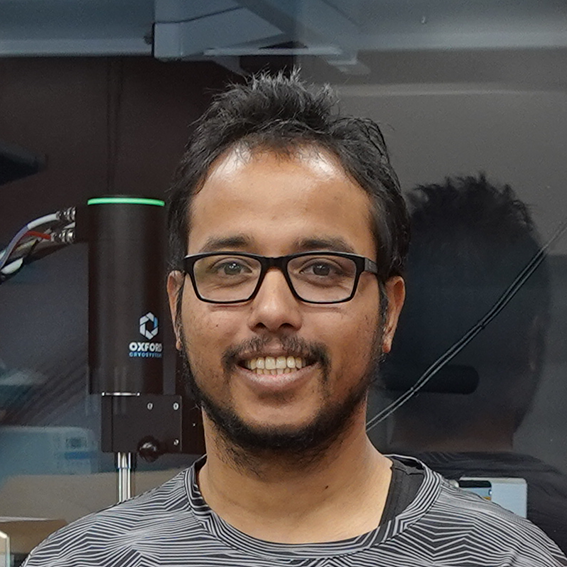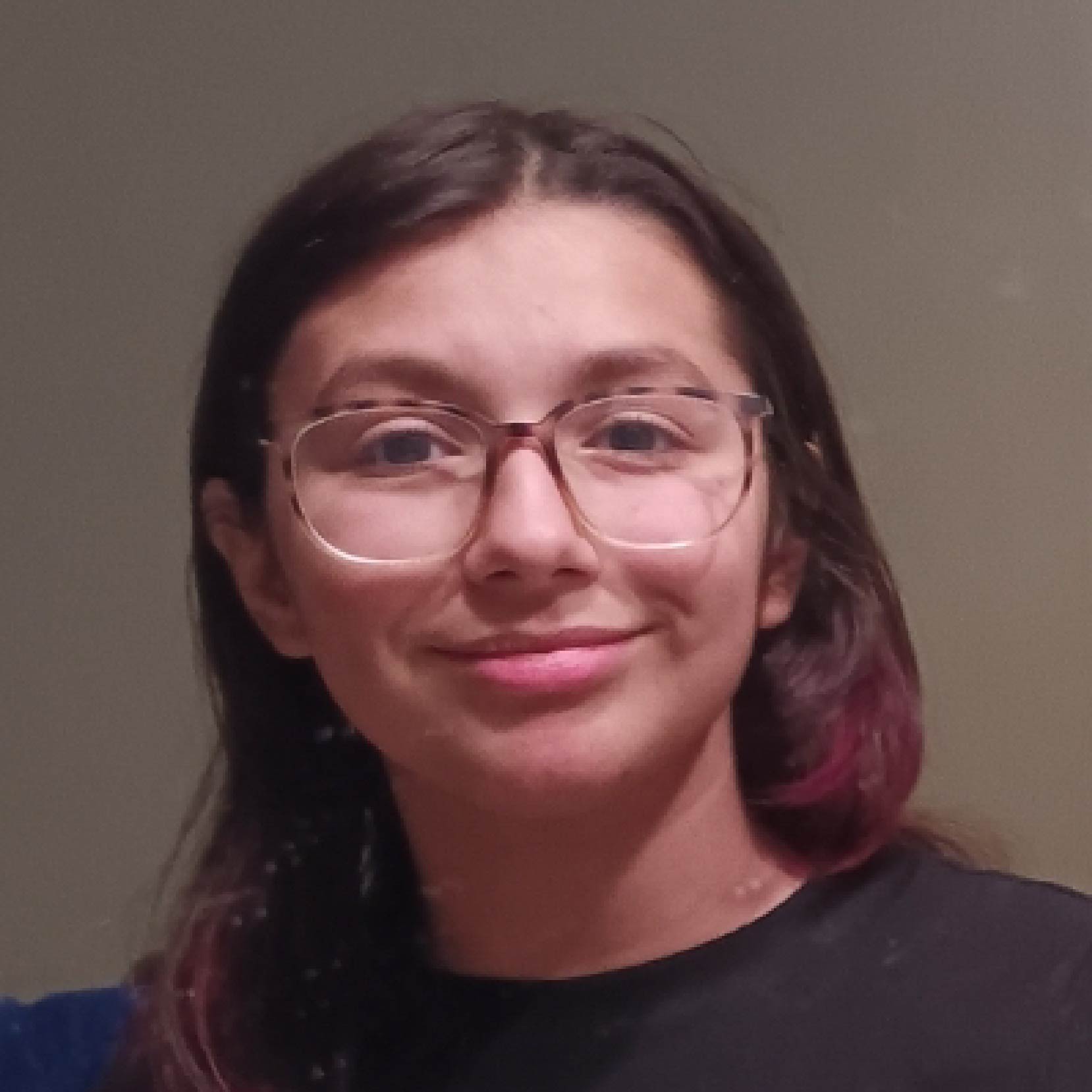Research Group
Postdoctoral Researchers
Dr. Sanjay Dutta (since 07/2023)

Sanjay graduated from Indian Institute of Technology Guwahati, India, in 2014 (M. Sc., Master of Science in Chemistry) and earned his doctoral degree in the field of materials sciences (organic electronic materials and X-ray crystallography) with Prof. Parthapratim Munshi at Shiv Nadar University, India, in 2021. After a short stay as a Senior Research Associate in the same group, he moved to the US in 2022 to join Prof. Caleb D. Martin’s research group at Baylor University, Texas, as a postdoctoral fellow in boron chemistry and X-ray crystallography. In July 2023, Sanjay accepted a position in the Stollenz group as Postdoctoral Researcher and Crystallographic Facility Manager of our new Bruker Venture dual-source single-crystal diffractometer. He is interested and trained in various fields of crystallography, organic and inorganic synthesis, materials, and computational chemistry.
Publications Dr. Sanjay Dutta (before KSU)
5) S. Dutta, P. Munshi*:
6) S. Dutta, Vikas, A. Yadav, R. Boomishankar, A. Bala, V. Kumar, T. Chakraborty, S. Elizabeth, P. Munshi*:
7) K. K. Jha, S. Dutta, P. Munshi*:
8) K. K. Jha, S. Dutta, S. Sar, S. Sen, P. Munshi*:
9) S. Dutta, A. Menon, P. Munshi*:
10) V. Kumar, R. Thaimattam, S. Dutta, P. Munshi, A. Ramanan*:
11) P. K. Dutta, A. Majumder, S. Dutta, B. B. Dhar, P. Munshi, S. Sen*:
12) S. Sahu, S. Dutta, G. Krishnamoorthy*:
13) S. Hati, P. K. Dutta, S. Dutta, P. Munshi, S. Sen*:
14) K. K. Jha, S. Dutta, V. Kumar and P. Munshi*:
15) N. Ghosh, R. Mondal, A. Deshmukh, S. Dutta, S. Mukherjee*:
Presentations Dr. Sanjay Dutta (before KSU)
S. Dutta, Caleb D Martin:
Potential Organoboron Adducts for Phase Transition, Ferroelectric and Piezoelectric Applications (poster presentation)
S. Dutta, Parthapratim Munshi:
Thermo-responsive single-component organic materials: Iso-symmetric phase transition, polymorphism and negative thermal expansion (poster presentation)
S. Dutta:
Competition between Positive and Negative Axial Thermal Expansion in an All-Organic Molecular Crystal Exhibiting Polymorphism and Single-Crystal to Single-Crystal Phase Transitions (oral presentation)
S. Dutta, Parthapratim Munshi:
Single-crystal to single-crystal phase transition and isostructural polymorphism in a potential organic ferroelectric material (poster presentation)
S. Dutta, Vikas, Parthapratim Munshi:
Ferroelectricity in organic materials: case of imidazole derivative (poster presentation)
S. Dutta, Anindya Menon, Vikas and Parthapratim Munshi:
Exploring Ferroelectricity in Organic Materials (Poster presentation)
Dr. Tomasz Kruczyński (since 01/2023)

Tomasz graduated from Gdańsk University of Technology, Poland, in 2009 (magister inżynier (mgr), equivalent to MEng, Master of Engineering in Chemical Technology) and earned his doctoral degree in the field of inorganic synthesis (highly sensitive magnesium cluster chemistry) with Prof. Hansgeorg Schnöckel at Karlsruhe Institute of Technology (KIT), Germany, in 2015. After working in industry, Tomasz continued to pursue an academic career and moved to the U.S. to join the Stollenz Group as full-time postdoctoral research scientist in inorganic/synthetic chemistry. He is interested and trained in various fields of inorganic synthesis, coordination chemistry, crystallography, and computational chemistry.
Publications Dr. Tomasz Kruczyński (before KSU)
Magnesium(I) Halide versus Magnesium Metal: Differences in Reaction Energy and Reactivity Monitored in Reduction Processes of P−Cl Bonds
Angew. Chem. 2019, 131, 726–731 (& Frontspiece).
Angew. Chem. Int. Ed. 2019, 58, 716–721 [Link] (& Frontspiece [Link]).
→This article was ranked as "Hot Paper".
2) Ł. Ponikiewski,* T. Kruczyński, M. Caporali, M. Peruzzini, D. Gudat, M. Walaszkowska,
J. Pikies*:
Reactions of the Lithiated Diphosphine tBu2P–P(SiMe3)Li with [(η6-C6H6)RuCl2] in the Presence of Tertiary Phosphines
Eur. J. Inorg. Chem. 2016, 4241–4249 [Link].
3) T. Kruczyński, F. Henke, M. Neumaier, K. Bowen, H. Schnöckel*:
Many Mg–Mg bonds form the core of the Mg16Cp*8Br4K cluster anion: the key to a reassessment of the Grignard reagent (GR) formation
process?
Chem. Sci. 2016, 7, 1543–1547 [Link].
4) A. Herman, S. Godlewska, Ł. Ponikiewski, T. Kruczyński, A. Dołȩga*:
Propeller-Like Chirality of Methyl-Tris (2,6-diisopropylphenoxy)Silylsulfide
Silicon 2016, 8, 105–110 [Link].
5) T. Kruczyński, P. Henke, T. Augenstein, N. Arleth, F. Breher,* H. Schnöckel*:
From MgBr via single-electron transfer (SET) to a paramagnetic Mg(II) compound and
back to Mg(I): [MgBr(L1)]2 and [K(thf)3]2[Mg2(L1)2], L1 = RN C(Me)C(Me) NR, R = 2,6-diisopropylphenyl
Chem. Commun. 2014, 50, 15677–15680 [Link].
6) T. Kruczyński, N. Pushkarevsky, P. Henke, R. Köppe, E. Baum, S. Konchenko, J. Pikies,
H. Schnöckel*:
Hunting for the Magnesium(I) Species: Formation, Structure, and Reactivity of some
Donor-Free Grignard Compounds
Angew. Chem. 2012, 124, 9159–9163 (& Back Cover).
Angew. Chem. Int. Ed. 2012, 51, 9025–9029 [Link] (& Back Cover [Link]).
7) T. Kruczyński, R. Grubba, K. Baranowska, J. Pikies*:
Syntheses and structures of the first terminal phosphanylphosphido complexes of molybdenum(IV)
Polyhedron 2012, 39, 25–30 [Link].
8) T. Kruczynski, J. Pikies, Ł. Ponikiewski*:
Trichloridobis(ethyldiphenylphosphine)(tetrahydrofuran)molybdenum(III)
Acta Crystallogr. E 2010, E66, m786 [Link].
Presentations Dr. Tomasz Kruczyński (before KSU)
(presenters underlined):
1) XV International Seminar of PhD Students on Organometallic and Coordination Chemistry,
April 5 (2014) in Świeradów-Zdrój, Poland:
T. Kruczyński, H. Schnöckel:
Magnesium(I) halides – a new route to the low-valent chemistry
2) 8th European Workshop on Phosphorus Chemistry, March 28 (2011) in Münster, Germany:
T. Kruczyński, R. Grubba, J. Pikies:
The route to the phosphanylphosphinidene complexes. Reactions of lithium diphosphanes
with molybdenum and tungsten cyclopentadienyl complexes
(oral presentation)
3) 18th International Conference on Phosphorus Chemistry, July 11 (2010) in Wrocław,
Poland:
T. Kruczyński, R. Grubba, K. Baranowska, J. Pikies:
New diphosphanes systems in molybdenum complexes (poster presentation)
4) XVIth International Winter School on Coordination Chemistry, December 8 (2008)
in Karpacz-Wrocław, Poland:
Ł. Ponikiewski, T. Kruczyński, J. Pikies:
Reaction of tBu2P-P(SiMe3)Li with [π-C6H6RuCl2]2. Synthesis and structure of [{(Et3P)2Ru}P2]2
(poster presentation)
Undergraduate Researchers
Mason Hipp (undergraduate researcher, since 09/2024)
Lily Baghramian (undergraduate researcher, since 01/2024)

Francis Ilori (First-Year Scholar, since 10/2024)

Rhianna Allen (First-Year Scholar, since 10/2024)

Last update: 01/02/2025









